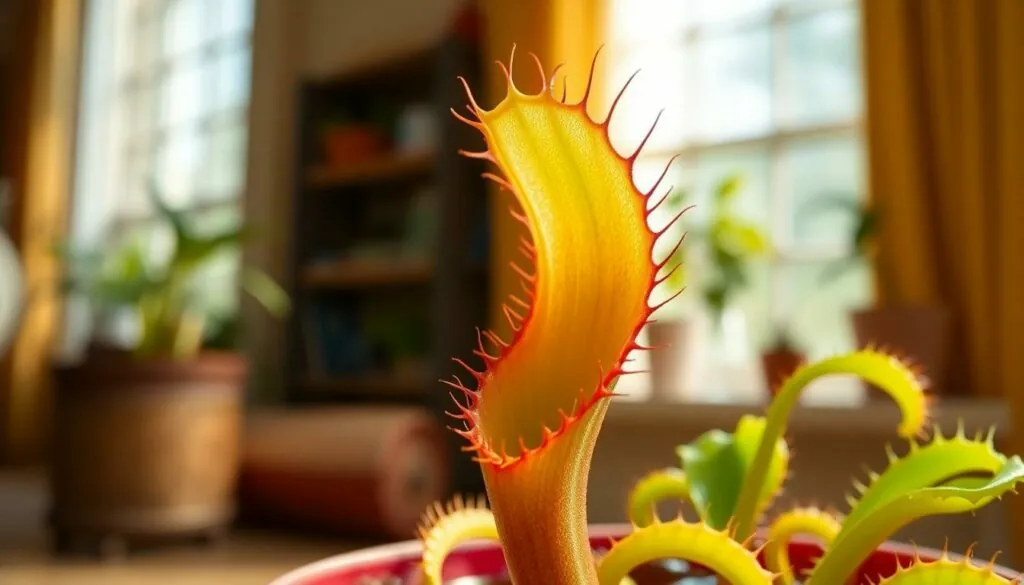Table of Contents
ToggleImagine a houseplant that doesn’t just sit there looking pretty but actively hunts for its dinner. Sounds like something out of a sci-fi movie, right? Welcome to the bizarre and fascinating world of carnivorous houseplants. These green predators add a touch of excitement to any home, turning the mundane task of watering into a thrilling adventure.
Overview of Carnivorous House Plants
Carnivorous house plants serve as fascinating additions to indoor gardens. Many species evolved to thrive in nutrient-poor environments, utilizing unique adaptations to capture and digest prey like insects. Notable types include Venus flytraps, pitcher plants, and sundews, each exhibiting distinctive trapping mechanisms.
The Venus flytrap utilizes modified leaves that snap shut when triggered by unsuspecting insects. This reaction facilitates the capture of prey, allowing the plant to absorb essential nutrients. Pitcher plants, on the other hand, attract insects with their enticing nectar and trap them in their deep, slippery pitchers. This method ensures that once an insect falls inside, escape becomes impossible.
Sundews employ a different strategy. These plants produce glandular hairs covered in a sticky substance, which entices insects to land. When contact occurs, the hairs curl around the prey, securing it for digestion. Each of these carnivorous plants appeals to various gardening enthusiasts, given their unique aesthetics and intriguing behaviors.
Caring for these plants involves specific considerations. They usually require high humidity, bright indirect light, and a well-draining soil mix, often composed of peat and perlite. Regular feeding with live insects or specialized fertilizers contributes to their overall health and vitality.
Integrating carnivorous house plants into home decor not only enhances aesthetics but also creates an engaging conversation piece. With proper care, they thrive indoors, bringing excitement to the routine of plant care. These vibrant predators transform any room into a dynamic ecosystem while simplifying pest control efforts.
Types of Carnivorous House Plants

Carnivorous house plants offer a captivating blend of beauty and functionality. Here are a few notable types that thrive indoors.
Venus Flytrap
Venus flytraps capture insects with their unique snapping leaves. These plants thrive in environments rich in humidity and require bright indirect light. Leaf lobes lie closed to lure prey, using nectar as bait. Once an unsuspecting insect triggers sensitive hairs, the lobes snap shut, trapping the prey. This fascinating mechanism allows them to digest insects effectively, extracting essential nutrients.
Pitcher Plants
Pitcher plants utilize specialized structures resembling deep, tubular pitchers. These structures attract insects with colorful patterns and sweet nectar. Insects slip into the slippery walls, finding it difficult to escape. Digestive fluids at the bottom of the pitcher break down the trapped prey. Types like the Nepenthes and Sarracenia are popular choices for indoor cultivation, thriving in bright light and high humidity.
Sundews
Sundews are known for their glandular hairs that exude a sticky substance, which attracts insects. This versatile plant thrives in a variety of growing conditions, though it prefers bright indirect light and well-draining soil. When an insect contacts the sticky hairs, the leaves curl around the prey, ensuring it remains trapped. This efficient method of nutrient acquisition makes sundews excellent additions to any carnivorous plant collection.
Care and Maintenance
Caring for carnivorous houseplants involves specific requirements that ensure their growth and vitality.
Light Requirements
Bright, indirect light suits the needs of most carnivorous houseplants. This light intensity mimics their natural habitats, allowing for optimal photosynthesis. Direct sunlight can cause leaf burn, particularly in species like Venus flytraps. During the day, placing these plants near a window with filtered light promotes healthy growth. Alternatively, using grow lights can provide adequate illumination for those growing indoors without sufficient natural light. Each plant species may have slight variations in light preferences, making it essential to adjust lighting according to individual needs.
Watering Guidelines
Carnivorous houseplants thrive in consistently moist conditions. Rainwater or distilled water works best, as tap water can contain minerals that harm these species. Watering should take place whenever the soil feels dry, ensuring not to let the plants sit in standing water. Most species, including sundews and pitcher plants, benefit from being watered from the bottom to allow for proper moisture absorption. Recognizing changes in the soil’s texture can help determine the best watering schedule, as each plant’s need may differ slightly based on its growth stage and environmental conditions.
Soil Composition
A well-draining soil mix is critical for carnivorous houseplants. Using a combination of sphagnum moss, perlite, and sand creates an ideal growing medium that mimics their native environments. This mix promotes drainage while retaining necessary moisture. Avoiding standard potting soil is crucial, as it can lead to root rot due to poor drainage. Adjusting the proportions in the soil mix based on plant species can enhance growth, allowing for a dynamic and vibrant indoor garden. Understanding these soil requirements helps cultivate thriving carnivorous plants.
Benefits of Having Carnivorous House Plants
Carnivorous house plants offer numerous advantages that enhance both the environment and the atmosphere of a home. They effectively act as natural pest control agents, capturing and digesting insects that can plague indoor spaces. From flies to gnats, these plants reduce unwanted pests without the need for chemical insecticides.
Aesthetically pleasing, carnivorous plants add unique beauty to home decor. Their striking appearances and intriguing trapping mechanisms captivate attention, often becoming conversation starters. People find their unusual characteristics fascinating, which adds an element of wonder to indoor gardening.
Additionally, caring for these plants fosters a deeper connection to nature. Engaging with their specific needs, such as humidity and lighting, encourages a sense of responsibility and awareness of ecological systems. Owners enjoy the satisfaction of nurturing life and witnessing the unique ways these plants thrive.
Moreover, carnivorous plants contribute to indoor air quality. They naturally promote a balanced ecosystem by attracting beneficial insects while minimizing the presence of harmful ones. This promotes a healthier living environment.
Many species, including the Venus flytrap, pitcher plants, and sundews, have adapted to thrive in low-nutrient settings. These adaptations heighten their appeal as low-maintenance house plants, allowing them to flourish even for those without extensive gardening experience.
Incorporating carnivorous house plants creates a dynamic and engaging space. Their presence invites curiosity and enhances an individual’s understanding of diverse plant behaviors. With these benefits, it’s easy to see why they are increasingly popular among plant enthusiasts and casual owners alike.
Common Challenges and Solutions
Maintaining carnivorous houseplants presents unique challenges. High humidity levels frequently constitute a significant hurdle. A solution involves using a humidity tray filled with water and pebbles or a room humidifier.
Another common issue is inadequate lighting. Carnivorous plants often thrive in bright, indirect light. Positioning them near a south or east-facing window provides ample exposure without direct sunlight, which can scorch their leaves.
Overfeeding poses risks as well. While feeding insects is essential, excessive feeding can lead to mold growth and root rot. A balanced approach—feeding once every two weeks—is advisable for optimal health.
Pest infestations can also affect these plants. Aphids and spider mites may disrupt growth and health. Regularly inspecting for pests and using insecticidal soap helps manage infestations effectively.
Water quality is critical for carnivorous plants. They prefer distilled, rain, or reverse osmosis water due to sensitivity to chemicals in tap water. Regular testing of water ensures they receive the best care possible.
Repotting may become necessary over time. Noticing stunted growth indicates it’s time for this process. Choosing a well-draining soil mix specifically designed for carnivorous plants promotes proper drainage and nutrient availability.
With proper attention, it’s possible to overcome these challenges. Cultivating awareness of their specific needs ensures that carnivorous houseplants thrive, enhancing both the home environment and the owner’s gardening experience.
Carnivorous houseplants offer a captivating blend of beauty and functionality that can elevate any indoor space. Their unique adaptations not only make them fascinating to observe but also provide effective natural pest control. By incorporating these remarkable plants into home decor, individuals foster a deeper connection with nature while enhancing their living environment.
With the right care and attention, even novice gardeners can successfully maintain these low-maintenance species. The rewards of nurturing carnivorous houseplants extend beyond aesthetics, encouraging responsibility and awareness of ecological systems. Embracing these extraordinary plants truly transforms the gardening experience into an engaging adventure.







